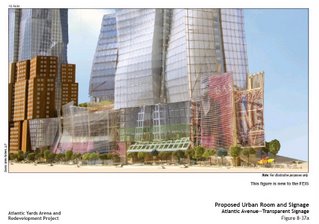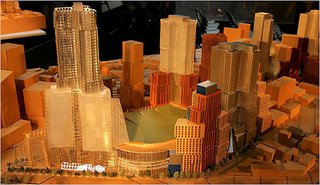 It's a basic architectural detail that would inevitably become public, but the state agency supervising the Atlantic Yards project won't disclose how far the planned arena would be set back from the street, saying security concerns mandate confidentiality.
It's a basic architectural detail that would inevitably become public, but the state agency supervising the Atlantic Yards project won't disclose how far the planned arena would be set back from the street, saying security concerns mandate confidentiality.Meanwhile, though state documents are vague about the setbacks, graphics, though not necessarily to scale, in the Final Environmental Impact Statement (FEIS) suggest some parallels to the situation that recently caused alarm in Newark, even though the arena there's a standalone box, while the Brooklyn arena would be enveloped in four towers.
(Graphic from the FEIS. Several other graphics attached to Chapter 8, Urban Design, also show segments of the arena along Atlantic and Flatbush avenues fairly close to the street.)
Newark comparison unresolved
Last month, officials in Newark decided to close streets abutting the about-to-open Prudential Center arena to guard against terrorist attacks. "You can't construct an arena and put it right against a street in a post 9/11 world," said Newark Police Director Garry McCarthy said.
Officials in New York, however, have so far been unwilling to put the issue to rest by disclosing the distance between the Brooklyn arena and the street. That raises the possibility that, even though the New York Police Department (NYPD) has no plans to close streets around the arena block, the contrast with Newark, at least in part, may not be that great. (Unlike in Newark, there's no slack in the Brooklyn street system for closings.) It also allows for the speculation that architectural plans are being revised to create more distance--or barriers--between the arena and the street.
 Empire State Development Corporation (ESDC) spokesman A.J. Carter told me yesterday, "The NYPD, which has been involved in discussions on the issue, has asked that security and anti-terrorism matters not be discussed publicly. As a result, beyond what is in the GPP [General Project Plan] and the FEIS, we will not discuss setback details."
Empire State Development Corporation (ESDC) spokesman A.J. Carter told me yesterday, "The NYPD, which has been involved in discussions on the issue, has asked that security and anti-terrorism matters not be discussed publicly. As a result, beyond what is in the GPP [General Project Plan] and the FEIS, we will not discuss setback details."(The graphic is from the FEIS--note that the green space is on the rooftop of the arena, and there's no indication in other renderings that it overhangs the building. Click to enlarge.)
Curiously enough, though Design Guidelines attached to the GPP provide copious details (example), I couldn't find anything specific about the arena setbacks.
The NYTimes's estimate
 Last Thursday, I asked Carter if the state could confirm the New York Times's estimate that "renderings of Atlantic Yards show the arena about 75 feet back from Atlantic Avenue and about 150 feet from Flatbush Avenue."
Last Thursday, I asked Carter if the state could confirm the New York Times's estimate that "renderings of Atlantic Yards show the arena about 75 feet back from Atlantic Avenue and about 150 feet from Flatbush Avenue."He responded at the end of the day Friday: "You'll have to ask Forest City Ratner. We don't know what renderings the Times were looking at."
Indeed, a photo of an Atlantic Yards model (above) published 5/12/06 by the Times casts doubt on claims of a 75-foot arena setback from Flatbush Avenue.
(Click to enlarge.)
Design Guidelines inconclusive
The Design Guidelines attached to the Atlantic Yards General Project Plan approved by the ESDC are inconclusive. A passage on p. 9 indicates that a "street wall" need not be at the sidewalk:
“Street wall” shall mean the portion of a building façade facing a street line and located between a street line and a line parallel to such street line at a depth of 100 feet.
Do the guidelines suggest that the street walls for the arena would be along the street rather than set back? It's unclear, though retail would be at the street. From p. 24-25:
iv. Arena. The street walls of the Arena along Flatbush Avenue and Atlantic Avenue shall include glass elements, including a continuous glazed area with a minimum width of 125 feet and a minimum surface area of 7500 square feet, such glazed area to commence at the height of the Arena concourse level. The street walls of ground floor retail uses located along and opening on to the street shall be glazed for a minimum of 70% of such street wall to a height of twelve feet, provided that no glazing shall be required for the sidewalk market along Atlantic Avenue described in Clause (g)(i) below.
 The Atlantic Avenue and Flatbush Avenue ground floor street frontages of the Arena Block shall incorporate a variety of retail and pedestrian based activities, including retail space accessible to the street and pedestrian seating areas. Not less than 40% of the Atlantic Avenue, 15% of the Flatbush Avenue street frontages, shall be devoted to retail uses, which may include eating and drinking establishments. The Atlantic Avenue retail requirement shall include retail use in front of the Arena volume which may include a sidewalk market opening on the street, provided that the market shall not occupy more than 180 linear feet of the Atlantic Avenue frontage. The Flatbush Avenue Street frontage shall incorporate a sitting area with a minimum length of 150 feet of which 40% may be in conjunction with an adjoining retail use.
The Atlantic Avenue and Flatbush Avenue ground floor street frontages of the Arena Block shall incorporate a variety of retail and pedestrian based activities, including retail space accessible to the street and pedestrian seating areas. Not less than 40% of the Atlantic Avenue, 15% of the Flatbush Avenue street frontages, shall be devoted to retail uses, which may include eating and drinking establishments. The Atlantic Avenue retail requirement shall include retail use in front of the Arena volume which may include a sidewalk market opening on the street, provided that the market shall not occupy more than 180 linear feet of the Atlantic Avenue frontage. The Flatbush Avenue Street frontage shall incorporate a sitting area with a minimum length of 150 feet of which 40% may be in conjunction with an adjoining retail use.From the Design Guidelines (p. 33):
Arena Block
Height, Setback, Envelope, and Architectural Controls – Individual Buildings
a. Arena
i. Maximum Building Height: 150 feet
ii. Setbacks: The Arena may rise without setback to the maximum building height.
iii. Architectural Controls: The Arena façade shall include transparent elements in the Atlantic Avenue and Flatbush Avenue street walls allowing for views into the arena concourse from the adjoining sidewalks.
FCR silence
Forest City Ratner isn't talking about security. "As a matter of common sense, and at the advice of the NYPD and our own anti-terrorism consultants, we will not ever publicly discuss our security or anti-terrorism measures for very obvious reasons," Forest City Ratner executive Bruce Bender told the Courier-Life chain, in an article published this week.
(Emphasis added)
A security consultant to the project, Jeffrey Venter, gave a similar message in an affidavit in defense of the pending lawsuit challenging the legitimacy of the Atlantic Yards environmental review. He stated:
If information regarding the security design parameters and limits of a major project were to be disclosed to the public, the safety of the arena and surrounding area could be easily compromised.
That argument is worth taking seriously. But there's a difference between security measures and architectural plans that show the distance from a building to the street, information that eventually would be "disclosed to the public."
The ESDC or the developer could have put the setbacks issue to rest, but they haven't. Perhaps the call by eight local elected officials for an independent security study will make public such basic facts.
Forest City Ratner has never been about doing anything that is in the best interests of the public no matter how serious that may be.
ReplyDeleteForest City Ratner has always been about maximum profit and subsidy for itself and minimum benefit for the public.
ESDC has never been about a clear understanding of this megadevelopment. Nor has ESDC been about demanding that it be improved or about analyzing how that could be done. ESDC has been about maximum accommodation of Ratner.
There have been multiple opportunities like this for politicians to peal away from supporting this megadeveloper/subsidy- hog who has no true interest in serving the public. Plenty of those opportunities have been afforded by Ratner’s own poor conduct. Spitzer has never distanced himself from this megadevelopment. The real horror story in this saga is that Spitzer, who ran for office trumpeting public authority reform zest and credentials has served in office displaying anything but.
And the New York Times has never been about being astute and reporting on any of this.